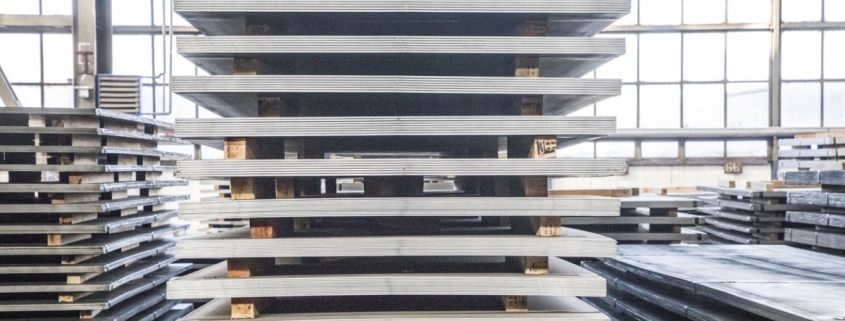ภาพรวมของแผ่นเหล็ก ASTM A553 ประเภท I (9% Ni)
การแนะนำ
ASTM A553 ประเภท I เป็นแผ่นเหล็กพิเศษที่ผสมนิกเกิล 9% ซึ่งออกแบบมาโดยเฉพาะสำหรับการใช้งานที่อุณหภูมิต่ำ เหล็กชนิดนี้ขึ้นชื่อในเรื่องความเหนียวและความแข็งแกร่งที่โดดเด่นที่อุณหภูมิต่ำมาก ทำให้เป็นวัสดุที่จำเป็นในอุตสาหกรรมที่ต้องเผชิญกับความหนาวเย็นจัด คุณสมบัติเฉพาะของ แผ่นเหล็ก ASTM A553 ชนิด I (9% Ni) ทำให้เป็นตัวเลือกที่สำคัญสำหรับการก่อสร้างถังเก็บ ภาชนะรับแรงดัน และโครงสร้างอื่นๆ ที่ต้องทนต่อความท้าทายของสภาพแวดล้อมที่เย็นจัด
องค์ประกอบทางเคมี
องค์ประกอบทางเคมีของแผ่นเหล็ก ASTM A553 ประเภท I (9% Ni) ได้รับการออกแบบอย่างพิถีพิถันเพื่อให้ได้คุณสมบัติตามที่ต้องการ ปริมาณนิกเกิล 9% เป็นส่วนผสมหลักที่ช่วยเพิ่มความทนทานของเหล็กที่อุณหภูมิต่ำ นี่คือองค์ประกอบทางเคมีทั่วไป:
คาร์บอน (C): ≤ 0.13%
แมงกานีส (Mn): ≤ 0.90% (การวิเคราะห์ความร้อน), ≤ 0.98% (การวิเคราะห์ผลิตภัณฑ์)
ฟอสฟอรัส (P) : ≤ 0.015%
ซัลเฟอร์ (S): ≤ 0.015%
ซิลิกอน (Si): 0.15–0.40% (การวิเคราะห์ความร้อน), 0.13–0.45% (การวิเคราะห์ผลิตภัณฑ์)
นิกเกิล (Ni) : 8.50–9.50% (การวิเคราะห์ความร้อน), 8.40–9.60% (การวิเคราะห์ผลิตภัณฑ์)
องค์ประกอบอื่นๆ: โมลิบดีนัมและไนโอเบียม (โคลัมเบียม) อาจมีอยู่ในปริมาณที่แตกต่างกันในปริมาณเล็กน้อย
ระดับคาร์บอนที่ควบคุมและการเติมนิกเกิลถือเป็นสิ่งสำคัญ เนื่องจากช่วยให้วัสดุมีคุณสมบัติที่อุณหภูมิต่ำเป็นพิเศษ
คุณสมบัติทางกล
แผ่นเหล็ก ASTM A553 ประเภท I (9% Ni) ได้รับการออกแบบมาเพื่อให้มีคุณสมบัติเชิงกลที่โดดเด่น โดยเฉพาะในสภาพแวดล้อมที่อุณหภูมิลดลงถึงระดับเยือกแข็ง คุณสมบัติเชิงกลที่สำคัญ ได้แก่:
ความต้านแรงดึง: 690–825 MPa (100–120 กิโลปาสคาล)
ความแข็งแรงของผลผลิต: ≥ 585 MPa (85 กิโลปาสคาล)
การยืดตัว: ≥ 18% (ความยาวเกจ 200 มม.)
ความเหนียวต่อแรงกระแทก: ความเหนียวสูง ผ่านการทดสอบที่อุณหภูมิต่ำถึง -196°C (-321°F)
คุณสมบัติเหล่านี้ได้มาจากการจัดเตรียมองค์ประกอบ การอบด้วยความร้อน และกระบวนการผลิตที่ได้รับการควบคุมอย่างระมัดระวัง เหล็กที่มีผลผลิตสูงและความแข็งแรงในการดึงทำให้สามารถรับมือกับความเค้นที่สำคัญได้โดยไม่เสียรูปหรือเสียหาย ในขณะเดียวกัน ความเหนียวต่อแรงกระแทกยังมีความสำคัญต่อการต้านทานการแตกแบบเปราะในสภาวะที่อุณหภูมิต่ำ
การใช้งาน
แผ่นเหล็ก ASTM A553 ประเภท I (9% Ni) ได้รับการออกแบบมาโดยเฉพาะสำหรับใช้ในสภาพแวดล้อมที่วัสดุสัมผัสกับอุณหภูมิที่ต่ำมาก การใช้งานที่สำคัญบางส่วน ได้แก่:
ถังเก็บ LNG: ถังเก็บก๊าซธรรมชาติเหลว (LNG) เป็นหนึ่งในการใช้งานหลักของแผ่นเหล็ก ASTM A553 ประเภท I LNG ถูกเก็บไว้ที่อุณหภูมิประมาณ -162°C (-260°F) ซึ่งต้องใช้วัสดุที่รักษาความสมบูรณ์ของโครงสร้างภายใต้เงื่อนไขเหล่านี้
ภาชนะแช่แข็ง: ภาชนะแช่แข็งที่ใช้สำหรับจัดเก็บและขนส่งก๊าซ เช่น ไนโตรเจน ออกซิเจน และไฮโดรเจน ในรูปของเหลว มักใช้เหล็ก ASTM A553 ประเภท I เนื่องจากสามารถทนต่ออุณหภูมิต่ำได้โดยไม่เปราะ
อุตสาหกรรมปิโตรเคมี: เหล็กกล้าชนิดนี้มักใช้ในอุตสาหกรรมปิโตรเคมีสำหรับถังเก็บและระบบท่อสำหรับของเหลวที่อุณหภูมิต่ำ ความต้านทานต่อการแตกแบบเปราะทำให้มั่นใจได้ถึงความปลอดภัยและความน่าเชื่อถือในการใช้งานที่สำคัญเหล่านี้
การบินและอวกาศ: ส่วนประกอบบางส่วนในอุตสาหกรรมการบินและอวกาศ ซึ่งวัสดุต้องสัมผัสกับอุณหภูมิที่ต่ำมากในระหว่างการบินหรือในอวกาศ อาจใช้เหล็ก ASTM A553 ประเภท I สำหรับประสิทธิภาพที่เชื่อถือได้
การใช้งานอุณหภูมิต่ำอื่น ๆ : คุณสมบัติของแผ่นเหล็ก ASTM A553 ประเภท I สามารถเป็นประโยชน์ต่อการใช้งานใดๆ ที่ต้องการประสิทธิภาพที่เชื่อถือได้ในอุณหภูมิต่ำ เช่น อุปกรณ์ทางทหารและการวิจัยบางประเภท
ข้อดีของแผ่นเหล็ก ASTM A553 Type I (9% Ni)
ความเหนียวที่เหนือกว่าที่อุณหภูมิต่ำ: การเติมนิกเกิล 9% ช่วยเพิ่มความเหนียวของเหล็กที่อุณหภูมิต่ำได้อย่างมาก ทำให้ทนทานต่อการแตกแบบเปราะได้ดีมาก
มีความแข็งแรงสูง: แผ่นเหล็กมีความแข็งแรงในการดึงและทนต่อแรงดึงสูง จึงเหมาะกับภาชนะที่มีแรงดันและการใช้งานที่ต้องรับแรงสูงอื่นๆ
ความทนทานและอายุการใช้งานยาวนาน: แผ่นเหล็ก ASTM A553 ประเภท I ขึ้นชื่อในเรื่องความทนทาน ช่วยให้มีอายุการใช้งานยาวนานแม้ในสภาพแวดล้อมที่ยากลำบากที่สุด
ความเก่งกาจ: แม้ว่าแผ่นเหล็กชนิดนี้จะใช้ในงานที่อุณหภูมิต่ำเป็นหลัก แต่คุณสมบัติของแผ่นเหล็กชนิดนี้ทำให้เหมาะสำหรับการใช้งานที่อุณหภูมิต่ำในหลายอุตสาหกรรม
งานประดิษฐ์และงานเชื่อม
แผ่นเหล็ก ASTM A553 ประเภท I สามารถผลิตและเชื่อมโดยใช้กระบวนการอุตสาหกรรมมาตรฐานได้ แม้ว่าจะต้องใช้ความระมัดระวังบางประการเนื่องจากวัสดุนี้มีนิกเกิลในปริมาณสูง โดยทั่วไป เหล็กจะถูกส่งมอบในสภาพที่ผ่านการชุบแข็งและอบให้ร้อน ซึ่งจะช่วยเพิ่มคุณสมบัติเชิงกลของเหล็ก
ข้อควรพิจารณาในการเชื่อม:
อุณหภูมิการอุ่นเครื่องและระหว่างทาง: จำเป็นต้องควบคุมอุณหภูมิในการอุ่นล่วงหน้าและระหว่างกระบวนการอย่างระมัดระวังเพื่อหลีกเลี่ยงความเครียดจากความร้อนที่อาจส่งผลต่อคุณสมบัติที่อุณหภูมิต่ำของเหล็ก
การอบชุบด้วยความร้อนหลังการเชื่อม (PWHT): ในบางกรณีอาจต้องใช้ PWHT เพื่อบรรเทาความเครียดที่เหลืออยู่และฟื้นคืนความทนทาน
การขึ้นรูป:
ความแข็งแรงสูงของเหล็กต้องได้รับการพิจารณาอย่างรอบคอบในระหว่างกระบวนการขึ้นรูปเพื่อหลีกเลี่ยงการแตกร้าวหรือปัญหาอื่นๆ การขึ้นรูปเย็นเป็นไปได้ แต่ปริมาณนิกเกิลที่สูงต้องได้รับการควบคุมอย่างระมัดระวังในกระบวนการขึ้นรูป
มาตรฐานและข้อกำหนด
แผ่นเหล็ก ASTM A553 ประเภท I (9% Ni) เป็นไปตามมาตรฐานสากล ทำให้เป็นวัสดุที่ได้รับการยอมรับทั่วโลกสำหรับการใช้งานในอุณหภูมิต่ำมาก มาตรฐานเหล่านี้รับประกันคุณภาพและประสิทธิภาพที่สม่ำเสมอ ไม่ว่าเหล็กจะผลิตหรือใช้ที่ใดก็ตาม
มาตรฐานที่เกี่ยวข้องบางส่วนได้แก่:
เอเอสทีเอ553: ข้อกำหนดมาตรฐานสำหรับแผ่นภาชนะรับแรงดัน เหล็กอัลลอยด์ ชุบแข็งและอบคืนตัว 8% และ 9% นิกเกิล
รหัสหม้อไอน้ำและภาชนะรับแรงดัน ASME (BPVC) รับรองเหล็ก ASTM A553 ประเภท I สำหรับใช้ในการก่อสร้างภาชนะรับแรงดัน
เอ็น 10028-4: มาตรฐานยุโรปสำหรับแผ่นเหล็กอัลลอยด์นิกเกิลที่ใช้ในอุปกรณ์รับแรงดัน ซึ่งรวมถึงวัสดุที่คล้ายคลึงกัน
บทสรุป
แผ่นเหล็ก ASTM A553 ประเภท I (9% Ni) เป็นวัสดุเฉพาะทางที่ออกแบบมาเพื่อใช้งานภายใต้สภาวะที่รุนแรง การผสมผสานอันเป็นเอกลักษณ์ระหว่างความแข็งแรง ความเหนียว และความต้านทานต่อการแตกแบบเปราะที่อุณหภูมิต่ำ ทำให้เหล็กชนิดนี้มีความจำเป็นในอุตสาหกรรมที่ความปลอดภัย ความน่าเชื่อถือ และประสิทธิภาพเป็นสิ่งสำคัญที่สุด
ตั้งแต่การจัดเก็บ LNG ไปจนถึงภาชนะสำหรับแช่เย็น แผ่นเหล็กชนิดนี้มีความสำคัญต่อโลกยุคใหม่ แผ่นเหล็กชนิดนี้ช่วยให้จัดเก็บและขนส่งของเหลวแช่เย็นได้อย่างปลอดภัยและมีประสิทธิภาพ การทำความเข้าใจคุณสมบัติ การใช้งาน และข้อควรพิจารณาในการผลิตเหล็ก ASTM A553 ประเภท I ถือเป็นสิ่งสำคัญสำหรับวิศวกร ผู้ผลิต และผู้เชี่ยวชาญในอุตสาหกรรมที่ทำงานกับวัสดุแช่เย็น
ประสิทธิภาพที่โดดเด่นของเหล็กชนิดนี้เป็นเครื่องพิสูจน์ถึงวิศวกรรมโลหะวิทยาขั้นสูงที่รับประกันว่าสามารถไว้วางใจวัสดุในการทำงานโดยไม่ลดคุณภาพแม้ในสภาพแวดล้อมที่เลวร้ายที่สุด




